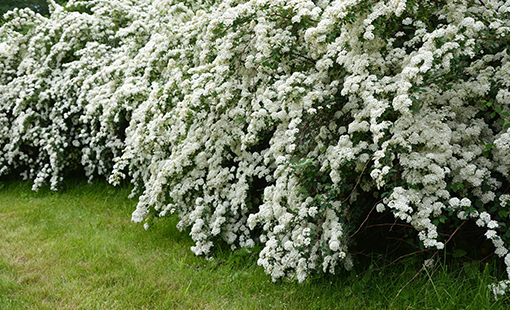
Flowering Shrub Spirea
Spirea is one of the most commonly used landscape plants, and for good reason. This hardy deciduous shrub has captivating three-season interest, with a graceful habit, attractive foliage and flowers that bloom over a long time.
Spirea is easy to grow in nearly any garden. It’s hardy in USDA zones 4-8, with many selections expanding that to 3-9. It is tolerant of a wide range of conditions, including poor soil, heat, cold, humidity, drought and urban pollution. Not only is spirea low-maintenance, but it also attracts butterflies and other insect pollinators.
These flowering shrubs’ delicate lacy flowers can be white, pink, red or mauve. Finely toothed foliage comes in shades of green, chartreuse, gold, blue, with some varieties putting on a showy fall display.
Planting
Follow these steps and space 2-15 feet apart, depending on the variety. Look to your plant’s tag for specific recommendations.
- Dig a hole slightly deeper than the root ball and 2 times wider.
- Remove the plant from the nursery pot and loosen the soil around the roots.
- Set the plant in the hole with the top of the root ball at or slightly above soil level.
- Backfill the hole with soil and tamp down slightly to remove air pockets. Water well.
- Mulch with a layer of shredded bark to retain moisture and suppress weeds.
Soil
Spirea isn’t fussy about soil type or pH. Make sure soil is well-draining.
Watering
Soil should be kept moist but not soggy. Water deeply but less frequently to encourage deep, healthy roots. Spirea is drought-tolerant once established.
Fertilizing
In early spring, apply a controlled-release fertilizer formulated for trees and shrubs according to instructions. Reapply each spring.
Sun Requirements
Spirea performs best in full sun, producing more blooms, vibrant color and brighter fall foliage. Plants can take light shade, with spring bloomers more shade tolerant than summer bloomers.
Category
Spirea is perennial in the sense that it comes back each year. But it is more correctly known as a shrub because its woody branches persist above ground all year round, and in spring, the new growth emerges not from the ground but on those branches.
Deer Resistance
Japanese spirea has good deer resistance. The Double Play® series is typically ignored by deer and even rabbits.
Pruning
Spirea has a naturally rounded habit without pruning. If you wish, you can trim after the flowers fade, which will encourage colorful new growth. Remove the oldest, woodiest stems every couple of years to keep growth fresh and vigorous.
Spirea in winter
All varieties will lose their foliage in winter, even in milder climates.
Height & Spread
Mature size ranges from 2-10 feet tall and wide. This fast grower can add up to 2 feet of new growth in a single season. Plants can be kept smaller with pruning.
Container Growing
Yes, spirea makes a good potted shrub! Try Double Play Doozie® for months of bloom or Double Play® Candy Corn® for a compact, colorful container.
Landscape Uses
This versatile shrub can be used in many ways. Here are some ideas:
- Feature a larger variety as a dramatic stand-alone specimen
- Plant in a row as a privacy screen along a property line
- Use smaller to medium varieties to divide garden rooms
- Incorporate a medium to large type as a background plant in a cottage-style or mixed border
- Use any size or type to accentuate a woodland setting
- Combine in a foundation planting along with other shrubs
- Use as low hedging along a pathway
- Massed along a slope for erosion control
- Smaller specimens can be planted in containers
Information courtesy of ProvenWinners.com

 Adams Fairacre Farms
Adams Fairacre Farms